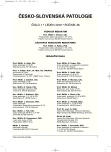Analysis of Bone Marrow Angiogenesis in Multiple Myeloma
Authors:
M. Tichý 1; V. Tichá 1; V. Ščudla 2; M. Šváchová 1; J. Zapletalová 3
Authors‘ workplace:
Ústav patologie LF UP a FNOl
1; III. interní klinika LF UP a FNOl
2; Ústav lékařské biofyziky LF UP, Olomouc
3
Published in:
Čes.-slov. Patol., 46, 2010, No. 1, p. 15-19
Category:
Original Article
Overview
The authors studied angiogenesis in trephine biopsy samples taken from the hip bone from a total of 51 patients with an as yet untreated plasma cell myeloma / multiple myeloma (MM). Microvessel density calculated to 1 mm2 was represented by monoclonal antibodies against CD34 and nestin. It was discovered that proliferating vessels labeled with anti-nestin antibody nearly never occur in the interstitial type of infiltration. The amount of proliferating vessels in nodular infiltrates is significantly lower compared to the capillary network labeled with antibodies against CD34. The density of proliferating vessels in nodular infiltrates significantly correlates with the proliferation index Ki67 of myeloma cells, not, however, with the degree of MM differentiation.
Key words:
plasma cell myeloma – angiogenesis – bone marrow – CD34 – nestin
Sources
1. Bartl, R., Frisch, B., Fateh-Moghadam, A. et al.: Histologic classification and staging of multiple myeloma. A retrospective and prospective study of 674 cases. Am. J. Clin. Pathol., 87, 1987, s. 342–355.
2. Bellamy, W. T., Richter, L., Frutiger, Y. et al.: Expression of vascular endothelial growth factor and its receptors in hematopoietic malignancies. Canc. Res., 59. 1999, s. 728–733.
3. Ehrmann, J., Kolář, Z., Mokrý, J.: Nestin as a diagnostic and prognostic marker: immunohistochemical analysis of its expression in different tumours. J. Clin. Pathol., 58, 2005, s. 222–223.
4. Hockfield, S., McKay, R. D.: Identification of major cell classes in the developing mammalian nervous system. J. Neurosci., 5, 1985, s. 3310–3328.
5. Kolář, Z., Ehrmann, J., Turashvili, G. et al.: A novel myoepitelial progenitor cell marker in the breast? Virchows Arch., 450, 2007, s. 607–609.
6. Kumar, S., Fonseca, R., Dispenzieri, A. et al.: Bone marrow angiogenesis in multiple myeloma: effect of therapy. Br. J. Haematol., 119, 2002, s. 665–671.
7. Kumar, S., Witzig, T. E., Timm, M. et al.: Expression of VEGF and its receptors by myeloma cells. Leukemia, 17, 2003, s. 2025–2031.
8. Mangi, M. H., Newland, E.: Angiogenesis and angiogenic mediators in haematological malignancies. Br. J. Haematol., 111, 2000, s. 43–51.
9. Matsui, W., Huff, C. A., Wang, Q. et al.: Characterization of clonogenic multiple myeloma cells. Blood, 103, 2004, s. 2332–2336.
10. Mokrý, J., Němeček, S.: Cerebral angiogenesis shows nestin expression in endothelial cells. Gen. Physiol. Biophys., 18, 1999, s. 25–29.
11. Mokrý, J., Cizková, D., Filip, S. et al.: Nestin expression by newly formed human blood vessels. Stem Cells Dev., 13, 2004, s. 658–664.
12. Munshi, N. C., Wilson, C.: Increased bone marrow microvessel density in newly diagnosed multiple myeloma carries a poor prognosis. Semin. Oncol., 28, 2001, s. 565–569.
13. Pruneri, G., Ponzoni, M., Ferrari, A. S. et al.: Microvessel density, a surrogate marker of angiogenesis, is significantly related to survival in multiple myeloma patients. Br. J. Haematol., 118, 2002, s. 817–820.
14. Rajkumar, S. V., Leong, T., Roche, P. C. et al.: Prognostic value of bone marrow angiogenesis in multiple myeloma. Clin. Cancer Res., 6, 2000, s. 3111–3116.
15. Reya, T., Morrison, S. J., Clarke, M. F. et al.: Stem cells cancer, and cancer stem cells. Nature, 414 (6859), 2001, s. 105–111.
16. Ryška, A., Hovorková, E., Ludvíková, M.: Angiogeneze v nádorech. Část II. Metody a význam kvantifikace angiogeneze jako prognostický ukazatel a cíl možných léčebných postupů. Čes.–slov. Patol., 36, 2000, s. 71–80.
17. Sezer, O., Niemoller, K., Encker, J. et al.: Bone marrow microvessel density is a prognostic factor for survival in patiens with multiple myeloma. Ann. Hematol., 79, 2000, s. 574–577.
18. Tichá, V., Tichý, M., Ščudla, V. et al.: Angiogeneze v kostní dřeni pacientů s plazmocytárním myelomem jako ukazatel biologického chování. Čes–slov. Patol., 42, 2006, s. 115–119.
19. Tichá, V., Tichý, M., Ščudla, V. et al.: Bone marrow angiogenesis in multiple myeloma after high–dose chemotherapy and autologous haematopoietic cell transplantation. Biomed Pap Med Fac Univ Palacky Olomouc Czech Repub.,150(Suppl.1) 2006,s.66–70.
20. Vacca, A., Ribatti, D., Runcali, L. et al.: Bone marrow angiogenesis and progression in multiple myeloma. Br. J. Haematol., 87, 1994, s. 503–508.
21. Vacca, A., Ribatti, D., Presta, M. et al.: Bone marrow neovascularization, plasma cell angiogenic potential and matrix metaloproteinase–2 secretion parallel progression of human multiple myeloma. Blood, 93, 1999, s. 3064–3073.
22. Vacca, A., Ria, R., Ribatti, D. et al.: A paracrine loop in the vascular endothelial growth factor pathway triggers tumor angiogenesis and growth in multiple myeloma. Haematologica, 88, 2003, s. 176–185.
Labels
Anatomical pathology Forensic medical examiner ToxicologyArticle was published in
Czecho-Slovak Pathology

2010 Issue 1
Most read in this issue
- Histopathological Classification of Idiopathic Interstitial Pneumonias
- Lymphoma of the Small Intestine
- Caspase 1, Superoxiddismutase (D-mutase) and Calretinin Expression in the Placenta and in the Basal Decidua in Preeclampsia
- Analysis of Bone Marrow Angiogenesis in Multiple Myeloma
